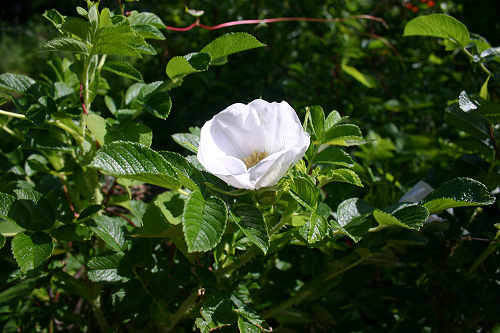A 365-Day Project
"We Are All Mozart"
A project to create
new works and change
the perception of the
music of our time.


 June 19, 2006
June 19, 2006 
We had a big, rolling thunderstorm today. The power was out for a while, and an internal quiet settled on the house, leaving only the sound of sheeting rain.
The rain was needed. It's been unusually hot for so early in the season, and the transplants were suffering. The hay crop has been erratic, and with the heat and rain, it's been rough on the farmers. There was a big cut Saturday, barely enough time to dry before this afternoon's deluge. Balers were rattling along windrows at high speed all morning. The season is short -- only about 90 days from frost to frost -- and so managing the crops is a tough and risky job. In some ways, we're little more independent than those in the cities who possess no survival resources at all. It's unlikely we could make it through a winter here (where temperatures can drop under 30 below) on our own in this century. With notice, perhaps we could plan well, but so many of the skills are lost. We could stay warm, of course, because we always keep the wood stacked and ready. And yes, there was a time we put up our own food -- canned, not frozen. Pickles and beans, ham, soda, even wine. Those times are gone by, along with dairy herds and self-sufficient farmers and independent spirits. Composers die easily.
Now our gardens are given as much to decorative flowerbeds as vegetables. It's been years since we had corn, and though the woodchuck eating our cabbages last year was a disappointment because we'd worked so hard on them (and they were a new variety we were excited to try), there was not much a pit-deep sense of unrecoverable loss. We did not panic. We would survive easily. Cabbage, even in deepest winter, will be heaped on supermarket shelves beside artichokes and strawberries.
Cabbages are planted again this year, and we'll put up a fence. But no, their loss will not cause us panic. In the meantime, the flowers are coming into bloom. After a decade, the cultivated roses have returned to their original wild form. The sunflowers are left to the birds, the pumpkins are decorative, the cucumbers destined for salads rather than jars. Bleeding hearts and columbine flourish on the dark side of the barn, hastas hug the steps, and morning glories once again begin their climb up along the front door arch. Alien flowers crowd in beside native ones. Clusters of irises and baptisia and hollyhocks and delphinium begin their blaze as lupine and poppies retire for the season. Day lilies have spread once more, and unexpected volunteers arrived with the high water last year, and again this spring a new line appeared along the brook's bank.
Day lilies signify. Vermont's towns used to meander high along the hills, before the valleys were cleared of swamps and the railroads came crashing through with their uneartlhy flat roadbeds, and old roads would wind along ridges. Some roads still pass through, but most other high roads have given way to disuse and erosion and the determination of witchgrass and then sumac and birch and butternut and finally maples and pines. Eventually the high farms fell into ruin and the barns first and then the homs themselves were overgrown. Rock foundations disarrayed themselves, wells collapsed, and trees grew up in the place of sturdy children.
The northland used to be sheep country. The touristic image of a woodland culture is recent. There was a time when the majority of the hills were cleared, and cattle and mostly sheep grazed. Villages could be seen unobscured from the hayloft. As times changed -- the World Wars, the exodus for the cities, the consolidation of agriculture -- the woodlands, no longer virgins, rightfully reclaimed the fields. And now the region is made up of villages and forests, with the occasional highland farm still in operation, the dairy cattle oblivious to their rarified place in history.
Wandering through those forests reveals the remants of civilization. Stone fences still separate trees from trees. A few artifacts survive -- pieces of glass, what might have been a gate, and a certain unexpected evenness where roads were once traveled, today occupied by brambles. You can see if you look. You must look. And you can imagine the hope and the happiness back into existence. Even the old roads up to the quarries are covered over, yet the quarries themselves -- vertical cuts two hundred feet deep into the ground made by hand and horse and ice and dynamite to recover verde antique that graced the Chicago Stock Exchange before cheaper Italian marble retired well-worn lifetimes of skill and sweat -- open up unexpectedly. Other quarries harbor sinuous serpentine, still melded to the asbestos which was also an invitation to earn one's livelihood and early tragedy.
The vanished dairy herds, bought out by a benevolent government twenty years ago during the milk surplus, have left behind pasture for equestrian hobbyists and specialty boutique vegetables-of-the-moment, eventually themselves to grow up into woodland or be cut into properly tidy parcels for the ever-slithering snakes of suburban development. Aerial photographs from fifty and seventy years ago can no longer help settle land disputes, for the fences have vanished and paths have become overgrown.
But on a good day, deep in the high woods in early summer, clumps of day lilies will be risen out of the ground, bright orange in a green and brown forest of hermit thrushes and veeries. Day lilies live only where people once brought them years and decades and generations past. The homes may collapse, the wood rot, the fences tumble, the fields push up to forest, trickles turn to streams and brooks, and the children grow and age and die and rest behind rusting fences.
But the day lilies will continue, a botanical painting that renews itself with the warming days. They will be here soon.
The thunderstorm is over, the power back on, the quiet lifted away by humming machines, and the sun begins its summer renewal again. This composer will stop one morning or evening. The day lilies will continue to signify.

Smaller and sweeter after a dozen generations is this white rose.